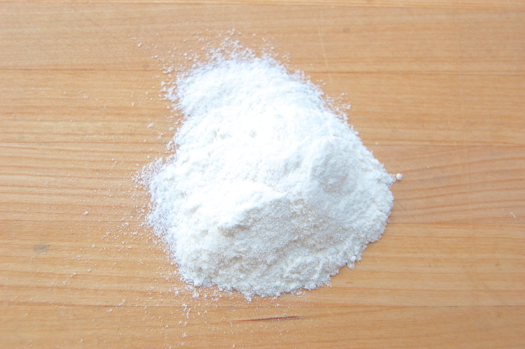Wheat Flour

Plain wheat flour is a go-to thickener in the kitchen, especially where sauces care concerned. In combination with butter or oil it becomes a roux, which is the basis of classic béchamel. White flour, most bakers know, is the ground endosperm of a wheat berry, the endosperm being the energy storehouse of the seed. Moisten the seed and enzymes in the endosperm go about breaking down the long chain starches that are stored there into simple sugars. These sugars fuel the sprout (contained in the germ) as it grows.
Why does a wheat plant store its fuel in the form of long chain sugars to begin with? Because they’re safer that way. Many molds, yeasts and bacteria lack the enzymes that are necessary to break up and digest long-chain starches. This storage system is a plant’s equivalent of a bank vault.
But it just so happens that those long chain starches are useful for béchamel-loving cooks. On a microscopic level, flour resembles thousands upon thousands of little bundles of reeds (the starches). Heat those bundles in a watery medium and those bundles start to fall apart. The long starch molecules tangle up with one another and even bond (very weakly) with each other. That tangle — combined with the remaining semi-dissolved bundles of starches — is the basis of flour thickening as it restricts the flow of the water within it. When done correctly the result is a very thick gel. When done incorrectly, well, you have water again.
Here I should insert that while flour granules start to come apart at about 140 degrees Fahrenheit, they need to come to a full boil in order to reach their full thickening potential. Once a flour-thickened mixture has reached the boil it’s as thick as it’s going to get. However wheat flour thickened mixtures tend to taste grainy/floury if they’re cooked only briefly. The reason for this is the size of the flour granules. When only briefly boiled they’re large enough to register on the tongue, and so need about 3-4 minutes of total simmering/boiling time before the granules become small enough that the starchy flavor and texture disappears. Be careful about your times, however, since as I said “un-thickening” is always a risk with starch gels.
Another important note is that acids also tend weaken flour-thickened gels because they inhibit bonding. Chilling and especially freezing is also generally a bad thing for any starch-thickened gel.
In general a wheat flour-thickened gels tends to be opaque, and that again is a factor of particle size. The relatively large granules bounce light rays back to our eyes and so give the gels a cloudy appearance. Another important consideration is that wheat flour contains several non-starch substances (protein, bran, etc.). Add that together with the extra cooking time required to eliminate the starchy taste and texture, and wheat flour should be considered only half as potent as an equivalent amount of corn starch.